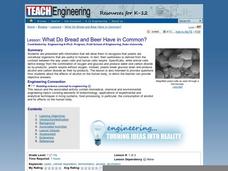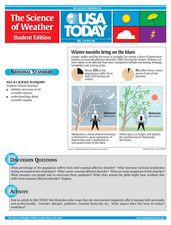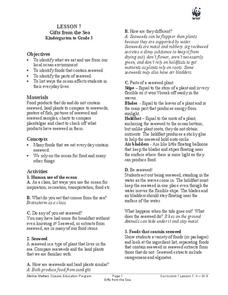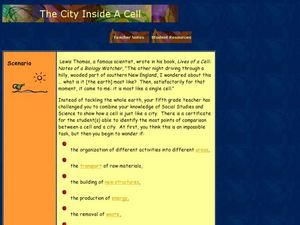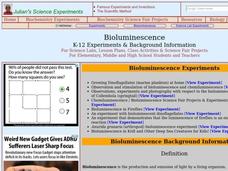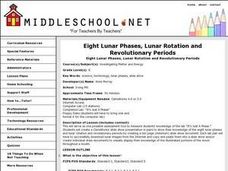Curated OER
What Do Bread and Beer Have in Common?
Students listen to an explanation of yeast cells and how they effect bread and beer. They discuss the ways alcohol affects the human body and participate in an indirect observation about cell respiration in yeast-molasses cultures.
Curated OER
Investigating Chemical and Physical Changes
Young scholars explore physical and chemical changes by looking at how different powders react to a variety of substances. They observe and identify the difference between physical and chemical change using a mystery powder.
Curated OER
Vocabulary Meanings #10
In this vocabulary meanings worksheet, students determine meanings to complete the sentences using context clue and words from a word bank. Students complete twelve sentences.
Curated OER
Sorting
Students experience sorting. In this organization lesson, students play a computer sorting game called "Flood Game" on the "Between the Lions" website. Students visit a library and observe and discuss book organization. Students work in...
Curated OER
Corn: An A-maizing Plant
Students explore the corn crop. In this farming instructional activity, students identify which states are in the corn belt and read about the history of corn, its uses and its development and growth. Students dissect a corn kernel....
Curated OER
The Science of Weather
Students read an article. In this seasons lesson, students discuss the seasons and seasonal affective disorder. Students find an article that illustrates other ways that the environment negatively effects humans.
Curated OER
Gifts from the Sea
Students discover the oceanic food chain. In this healthy eating instructional activity, student investigate the fish we eat and the food the fish eat. Students discover what ocean animals eat seaweed and what everyday foods we eat...
Curated OER
Gifts from the Sea
Students investigate parts of the ocean. In this seaweed lesson, students identify foods that contain seaweed, parts of seaweed, and how the ocean affects our lives. As a class students brainstorm ways we rely on the ocean and compare...
Curated OER
World Consumer Rights Day
In this World Consumer Rights Day instructional activity, students complete activities such as reading a passage, matching phrases, fill in the blanks, choose the correct word, multiple choice, unscramble the words, sequencing,...
Curated OER
Paper or Plastic: Exploring Renewable Resources.
Students discuss, develop, invent, and implement a plan for making informed personal economic decisions about renewable resources.
Curated OER
Oil on the Beach
Students explore how oil pollutes the oceans. For this science lesson, students investigate various materials that could be used to clean up an oil spill. Students discuss which materials worked best and how humans can reduce oil spills.
Curated OER
The City Inside a Cell
Students compare cell structure to the structure of a city. In this cell structure lesson, students investigate differences and similarities between cell structure and city structure. Students create a 3-dimensional, edible model of a cell.
Curated OER
Where Does Food Come From?
Students recognize that food we eat comes from farms. In this where does food come from lesson, students discuss planting crops and how they grow. Students plant seeds for edible crops and eat them when are ripe. Students sing a song...
Curated OER
Crops 2: What Plants Need to Grow
Students explore agriculture by participating in a plant growth activity. In this botany lesson, students discuss what types of plants grow in their local environment and what the plants need to survive. Students read assigned text about...
Curated OER
Bioluminescence
Students differentiate chemiluminescence from bioluminescence. In this biology lesson, students explain how fireflies and other animals emit light. They discuss the applications of engineered bioluminescence.
Curated OER
Differentiating for High Ability Students
You can challenge high ability students in your classroom with these differentiated lesson plans.
Curated OER
Bhopal - Covalent Bonding
Using the chemicals that leaked in the Bhopal gas tragedy of 1984, chemists examine covalent bonds. Provide for them the chemical reactions and have them draw Lewis diagrams for the molecules involved. That's about all there is to the...
Curated OER
Biodegradability
Students study the effects of water, salt water and heat on common household materials. They separate an emulsion and show that the materials are completely recoverable and observe the effect of acetone and water on polystyrene.
Curated OER
Philanthropy in Your Community
Students brainstorm how an action to benefit others is a type of philanthropy. They
identify the commonwealth approach to philanthropy,
plan and carry out a philanthropic action in their community and
reflect how their action qualifies...
Curated OER
What's the Matter? (Experiments)
Students observe a scientific discrepant event, and are then challenged to create experiments to solve the dilemma.
Curated OER
1st Grade - Act. 17: Observing Plants Through a Journal
First graders observe plants and write and illustrate what they have learned in their discovery journal.
Curated OER
1st Grade - Act. 22: Retelling the Tiny Seed
First graders write sentences and illustrate ways seeds travel.
Curated OER
Eight Lunar Phases, Lunar Rotation and Revolutionary Periods
Eighth graders create a slide show to show their knowledge of the eight lunar phases and lunar rotation and revolutionary periods.
Curated OER
Global Warming: Life in a Greenhouse
Students investigate the evidence and consequences of global warming. They read and discuss an article, conduct a debate, evaluate their community's climate statistics, log their gas consumption for a week, and develop a panel discussion...


